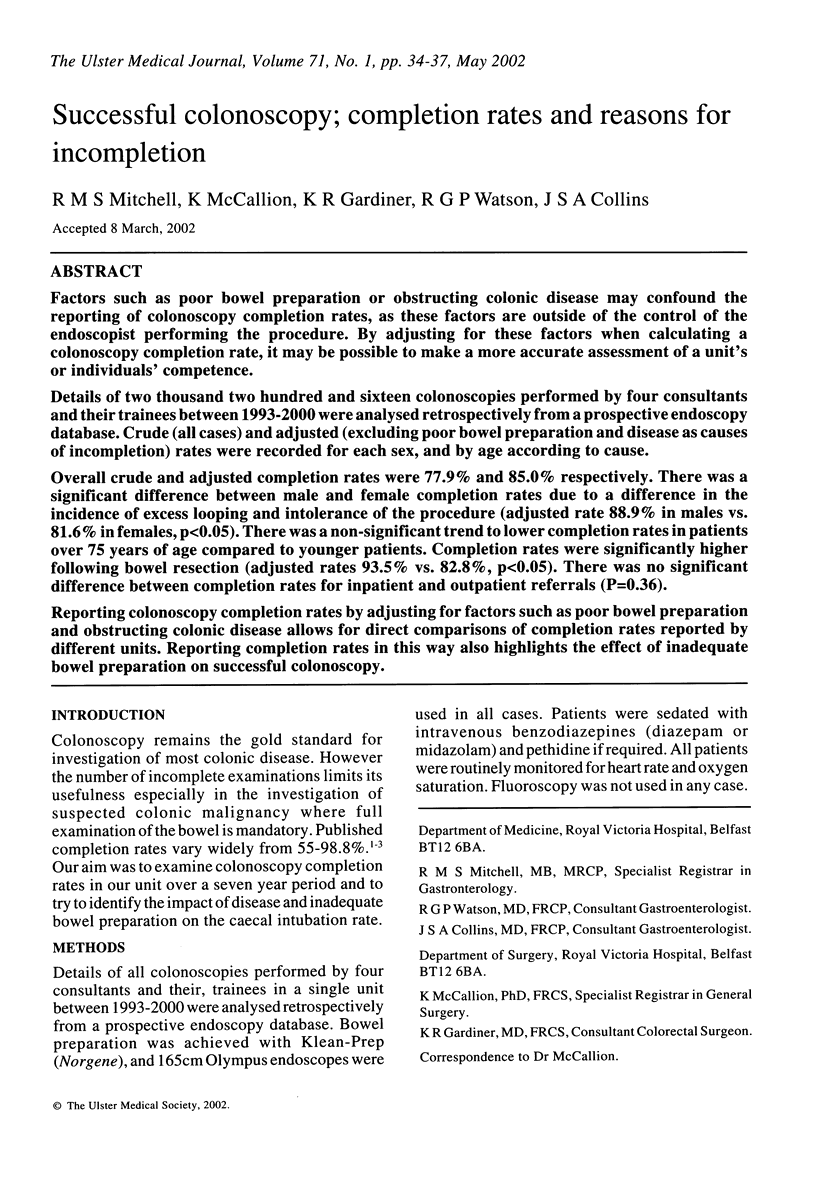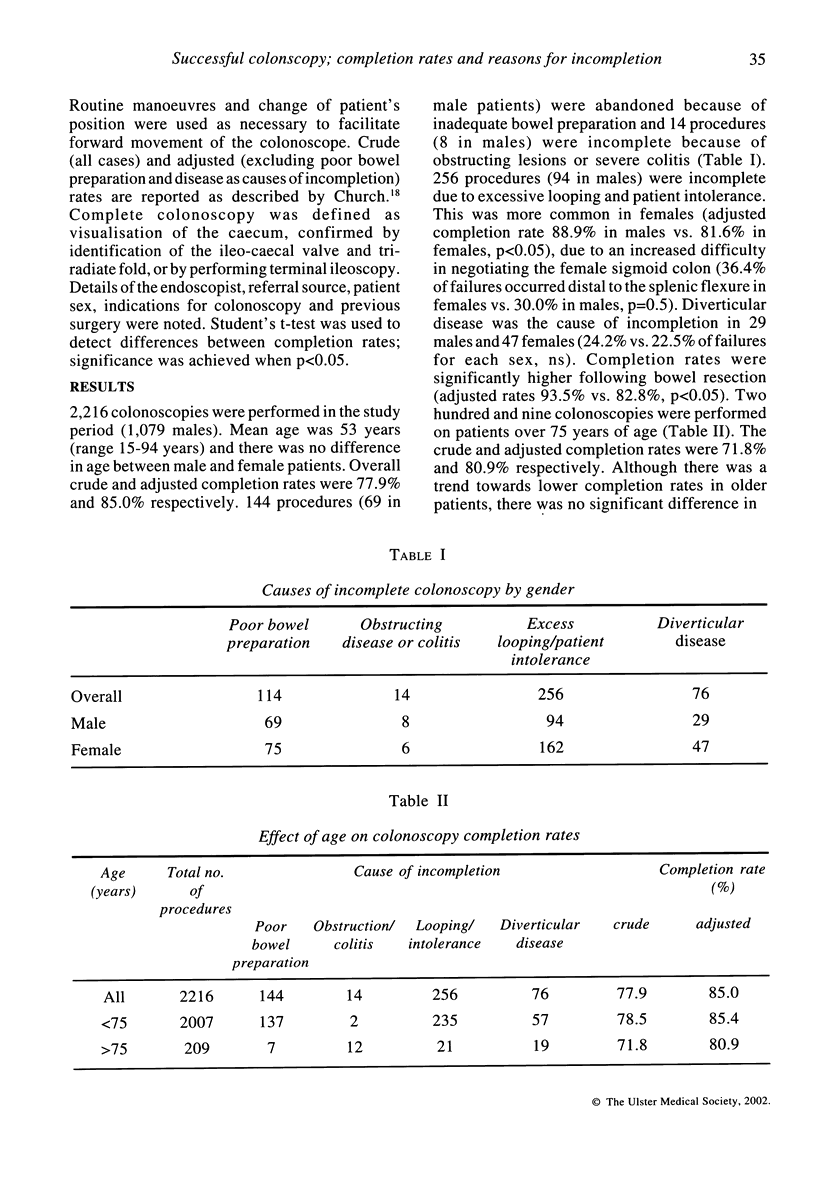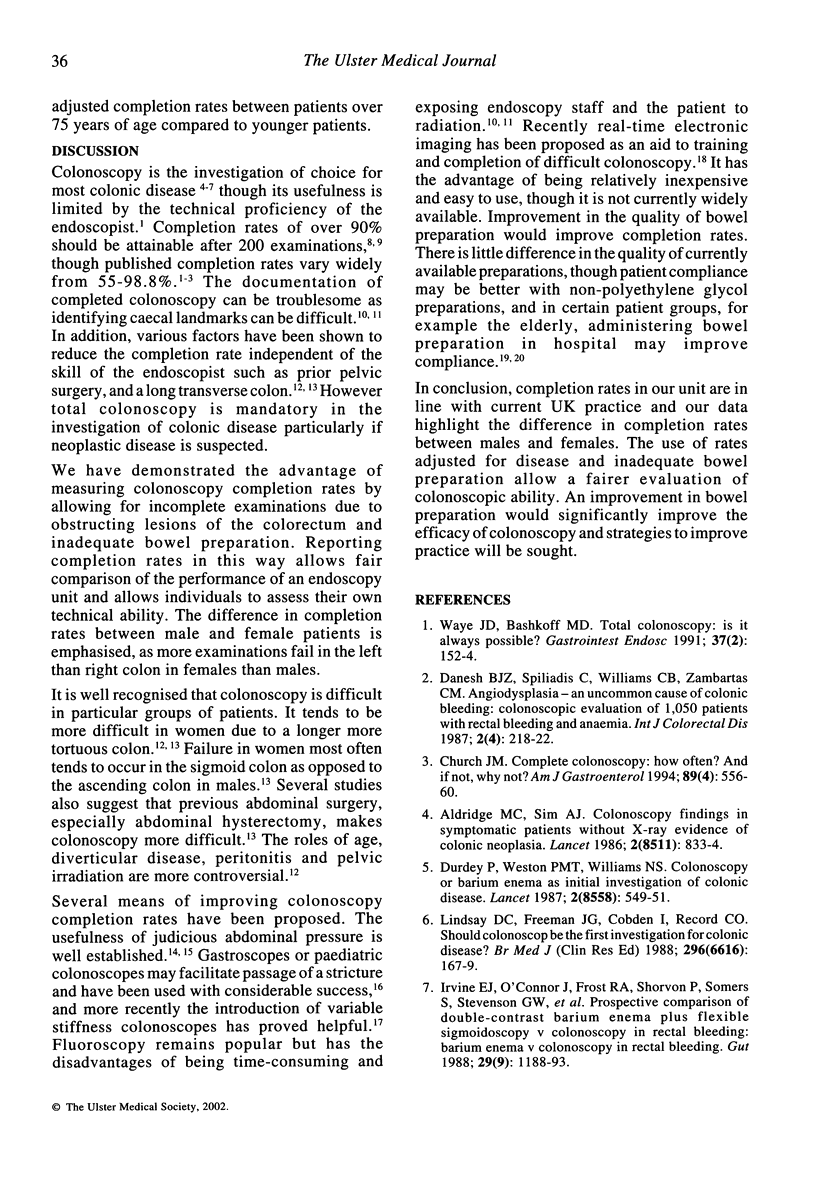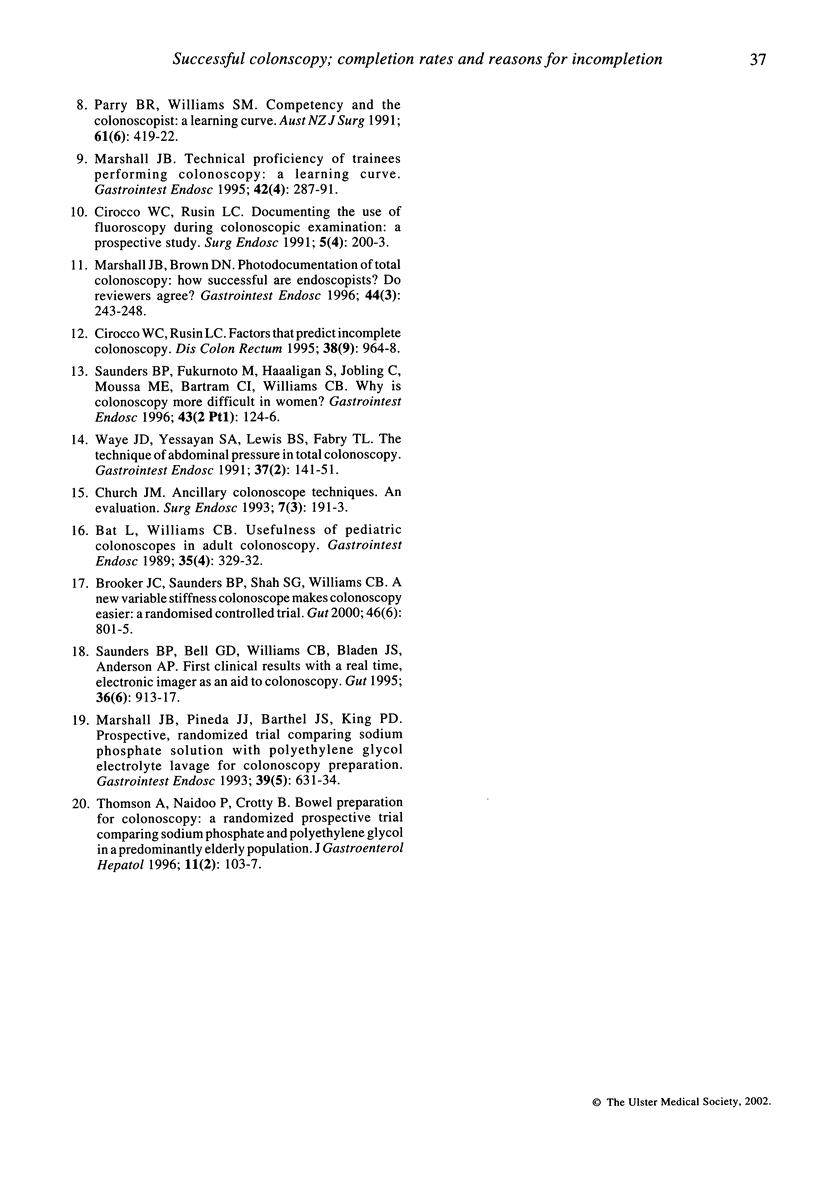Abstract
Factors such as poor bowel preparation or obstructing colonic disease may confound the reporting of colonoscopy completion rates, as these factors are outside of the control of the endoscopist performing the procedure. By adjusting for these factors when calculating a colonoscopy completion rate, it may be possible to make a more accurate assessment of a unit's or individuals' competence. Details of two thousand two hundred and sixteen colonoscopies performed by four consultants and their trainees between 1993-2000 were analysed retrospectively from a prospective endoscopy database. Crude (all cases) and adjusted (excluding poor bowel preparation and disease as causes of incompletion) rates were recorded for each sex, and by age according to cause. Overall crude and adjusted completion rates were 77.9% and 85.0% respectively. There was a significant difference between male and female completion rates due to a difference in the incidence of excess looping and intolerance of the procedure (adjusted rate 88.9% in males vs. 81.6% in females, p<0.05). There was a non-significant trend to lower completion rates in patients over 75 years of age compared to younger patients. Completion rates were significantly higher following bowel resection (adjusted rates 93.5% vs. 82.8%, p<0.05). There was no significant difference between completion rates for inpatient and outpatient referrals (P=0.36). Reporting colonoscopy completion rates by adjusting for factors such as poor bowel preparation and obstructing colonic disease allows for direct comparisons of completion rates reported by different units. Reporting completion rates in this way also highlights the effect of inadequate bowel preparation on successful colonoscopy.
Full text
PDF



Selected References
These references are in PubMed. This may not be the complete list of references from this article.
- Aldridge M. C., Sim A. J. Colonoscopy findings in symptomatic patients without X-ray evidence of colonic neoplasms. Lancet. 1986 Oct 11;2(8511):833–834. doi: 10.1016/s0140-6736(86)92869-2. [DOI] [PubMed] [Google Scholar]
- Bat L., Williams C. B. Usefulness of pediatric colonoscopes in adult colonoscopy. Gastrointest Endosc. 1989 Jul-Aug;35(4):329–332. doi: 10.1016/s0016-5107(89)72803-0. [DOI] [PubMed] [Google Scholar]
- Brooker J. C., Saunders B. P., Shah S. G., Williams C. B. A new variable stiffness colonoscope makes colonoscopy easier: a randomised controlled trial. Gut. 2000 Jun;46(6):801–805. doi: 10.1136/gut.46.6.801. [DOI] [PMC free article] [PubMed] [Google Scholar]
- Church J. M. Ancillary colonoscope insertion techniques. An evaluation. Surg Endosc. 1993 May-Jun;7(3):191–193. doi: 10.1007/BF00594106. [DOI] [PubMed] [Google Scholar]
- Church J. M. Complete colonoscopy: how often? And if not, why not? Am J Gastroenterol. 1994 Apr;89(4):556–560. [PubMed] [Google Scholar]
- Cirocco W. C., Rusin L. C. Documenting the use of fluoroscopy during colonoscopic examination: a prospective study. Surg Endosc. 1991;5(4):200–203. doi: 10.1007/BF02653264. [DOI] [PubMed] [Google Scholar]
- Cirocco W. C., Rusin L. C. Factors that predict incomplete colonoscopy. Dis Colon Rectum. 1995 Sep;38(9):964–968. doi: 10.1007/BF02049733. [DOI] [PubMed] [Google Scholar]
- Danesh B. J., Spiliadis C., Williams C. B., Zambartas C. M. Angiodysplasia--an uncommon cause of colonic bleeding: colonoscopic evaluation of 1,050 patients with rectal bleeding and anaemia. Int J Colorectal Dis. 1987 Nov;2(4):218–222. doi: 10.1007/BF01649509. [DOI] [PubMed] [Google Scholar]
- Durdey P., Weston P. M., Williams N. S. Colonoscopy or barium enema as initial investigation of colonic disease. Lancet. 1987 Sep 5;2(8558):549–551. doi: 10.1016/s0140-6736(87)92931-x. [DOI] [PubMed] [Google Scholar]
- Irvine E. J., O'Connor J., Frost R. A., Shorvon P., Somers S., Stevenson G. W., Hunt R. H. Prospective comparison of double contrast barium enema plus flexible sigmoidoscopy v colonoscopy in rectal bleeding: barium enema v colonoscopy in rectal bleeding. Gut. 1988 Sep;29(9):1188–1193. doi: 10.1136/gut.29.9.1188. [DOI] [PMC free article] [PubMed] [Google Scholar]
- Lindsay D. C., Freeman J. G., Cobden I., Record C. O. Should colonoscopy be the first investigation for colonic disease? Br Med J (Clin Res Ed) 1988 Jan 16;296(6616):167–169. doi: 10.1136/bmj.296.6616.167. [DOI] [PMC free article] [PubMed] [Google Scholar]
- Marshall J. B., Brown D. N. Photodocumentation of total colonoscopy: how successful are endoscopists? Do reviewers agree? Gastrointest Endosc. 1996 Sep;44(3):243–248. doi: 10.1016/s0016-5107(96)70159-1. [DOI] [PubMed] [Google Scholar]
- Marshall J. B., Pineda J. J., Barthel J. S., King P. D. Prospective, randomized trial comparing sodium phosphate solution with polyethylene glycol-electrolyte lavage for colonoscopy preparation. Gastrointest Endosc. 1993 Sep-Oct;39(5):631–634. doi: 10.1016/s0016-5107(93)70213-8. [DOI] [PubMed] [Google Scholar]
- Marshall J. B. Technical proficiency of trainees performing colonoscopy: a learning curve. Gastrointest Endosc. 1995 Oct;42(4):287–291. doi: 10.1016/s0016-5107(95)70123-0. [DOI] [PubMed] [Google Scholar]
- Parry B. R., Williams S. M. Competency and the colonoscopist: a learning curve. Aust N Z J Surg. 1991 Jun;61(6):419–422. doi: 10.1111/j.1445-2197.1991.tb00254.x. [DOI] [PubMed] [Google Scholar]
- Saunders B. P., Bell G. D., Williams C. B., Bladen J. S., Anderson A. P. First clinical results with a real time, electronic imager as an aid to colonoscopy. Gut. 1995 Jun;36(6):913–917. doi: 10.1136/gut.36.6.913. [DOI] [PMC free article] [PubMed] [Google Scholar]
- Saunders B. P., Fukumoto M., Halligan S., Jobling C., Moussa M. E., Bartram C. I., Williams C. B. Why is colonoscopy more difficult in women? Gastrointest Endosc. 1996 Feb;43(2 Pt 1):124–126. doi: 10.1016/s0016-5107(06)80113-6. [DOI] [PubMed] [Google Scholar]
- Thomson A., Naidoo P., Crotty B. Bowel preparation for colonoscopy: a randomized prospective trail comparing sodium phosphate and polyethylene glycol in a predominantly elderly population. J Gastroenterol Hepatol. 1996 Feb;11(2):103–107. doi: 10.1111/j.1440-1746.1996.tb00044.x. [DOI] [PubMed] [Google Scholar]
- Waye J. D., Bashkoff E. Total colonoscopy: is it always possible? Gastrointest Endosc. 1991 Mar-Apr;37(2):152–154. doi: 10.1016/s0016-5107(91)70674-3. [DOI] [PubMed] [Google Scholar]


